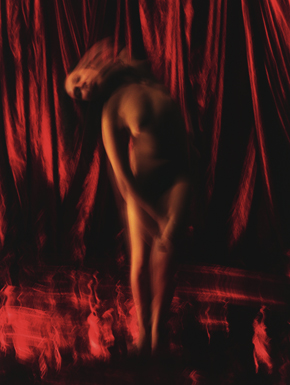Caitlin Sabo is a passionate fine art photographer. She has worked on her art for more than 20 years in Mexico before recently showing it abroad. Her first individual show in Europe, “Memories,” was held at Crisolart Galleries in Barcelona, October 2014.
Of “Memories,” Caitlin says:
“These are my painfully intimate self-portraits, the visual poetry born in the depths of my soul. The images explore the dualities in my life: the light and the shadows; the times when love and pain are one and the same; the closed eyes that see all, the open mouth from which no words come forth; being vulnerable, not knowing how to defend myself, the masks that I wear to protect myself, the agony of slowly pulling these masks off, one by one; what I am able to see, as well as what I am blind to, unable or unwilling to face, but that nonetheless, is clearly evident in my images.”
In addition, her recent collective exhibits include: the Summer Art Show Barcelona, Crisolart Galleries, August 2013; Stroke Art Fair Berlin, October 2013, represented by Crisolart; and the Miami River Art Fair, December 2013, represented by the Paul Cabezas Gallery. Caitlin also participated in the Chelsa Art Show at the Montserrat Gallery, New York City, February 2014, Art Curator Paul Cabezas; Homenaje a Cervantes & Shakespeare, May 2014, Crisolart Galleries Barcelona; a collective show at the Spanish Benevolent Society Gallery, New York, September 2014, Art Curator Paul Cabezas; International Biennial Art Miami, August 2015, Art Curator Paul Cabezas and September Art Rome; Flyer Art Gallery, Rome, Italy, September 2015, Art Curator Floriano Massera; Miami River Art Fair, December 2015, Art Curator Paul Cabezas, and Joyful Colors, Flyer Art Gallery, December 2015, Art Curator Floriano Massera.
Furthermore, her art was showcased in the 2013 winter edition of the New York magazine Art News, as well as the Barcelona-based magazine Artmosphere, 2013 winter edition and the 2014 fall edition.
Before becoming a fine art photographer, Caitlin was journalist. She worked in the print media in Texas and Latin America after graduating from The University of Texas, Austin with Bachelor of Journalism.
Caitlin studied photography at La Escuela Activa de Fotografía in Mexico City; she graduated with honors, using her first exposition “Remolino de Sueños” (“Whirlpool of Dreams”) as her thesis. It was a series of color nudes in movement, using film.
One image from this series, seen on this page, was included in a collective show in Houston, Texas in 1994.
Caitlin had two other individual shows in Mexico City. The first was a beautiful color series of 24 images of a couple giving birth: the final stages of labor, the interaction between the couple and the transformation of pain to joy as the new mother held their infant in her arms. The final image, a close up of their newborn, was in black and white. The show initially was presented in the Trotsky Museum; the director liked the work so much that he took it to many neighborhoods in Mexico City, where Caitlin talked about the images and people told her their own beautiful birthing experiences, opening up with stories they probably never had told anyone before.
Her third show, also in the Trotsky Museum, was “Urban Decay Textures,” an abstract color series taken in Mexico City and San Francisco, California. Caitlin used a large format film camera to create big close ups of the cracks in the pavement and walls in the world around her. The series was about perspective, how looking at things in a different way influences what we see and what we feel.
During that time, Caitlin also participated in multiple collective shows in the Museo Universitario del Chopo (a museum that is part of Mexico’s National University and is known as home for cultural diversity.)
Caitlin then worked exclusively in black and white, discovered the Holga (a medium format plastic “toy” camera) and did her first series of nude self portraits, “Survival Portraits: A Journey Within.” They were taken in Mexico City and Youngstown, Ohio, where she watched her mother slowly dying of lung cancer during two months of hospitalization. They are all painful multiple exposures, her way of dealing with grief, loss. Caitlin has not shown this series to date. The original prints from her darkroom are on gold-toned warm archival paper, with a watercolor texture; the toning provides a soft subtle blue.
Caitlin did a second important series, “And when I awoke I was drowning.” These are the images that she made to deal with her son Joshua’s death. She needed self-portraits to work through her pain and loss, but she could not bring herself to use her own body; she hired actors and models, asking them to portray her pain as they saw fit, and they did. They also gave her an unexpected gift of beauty and joy in their work. These images still were film, black and white, but this was the time when digital photography was in its initial stages. Caitlin made single and multiple exposures on film; she also scanned her Hasselblad negatives and began combining images in Photoshop. This series has not been shown yet.
Her later work is all digital, mostly black and white, strongly influenced by her darkroom days, toning and mordençage; without those years, she would not be the photographer she is today.
Photography is Caitlin’s vocation, passion and calling in life. Nowadays, she does very intimate, often painful, self-portraits, nudes, and interpretative portraiture. After years as a “studio” photographer, she was truly surprised when she discovered a passion for street photography; these images include Mexico City, New Orleans, Barcelona and Italy. She also has a fascination with mannequins, which she finds to be “Almost Human.”
